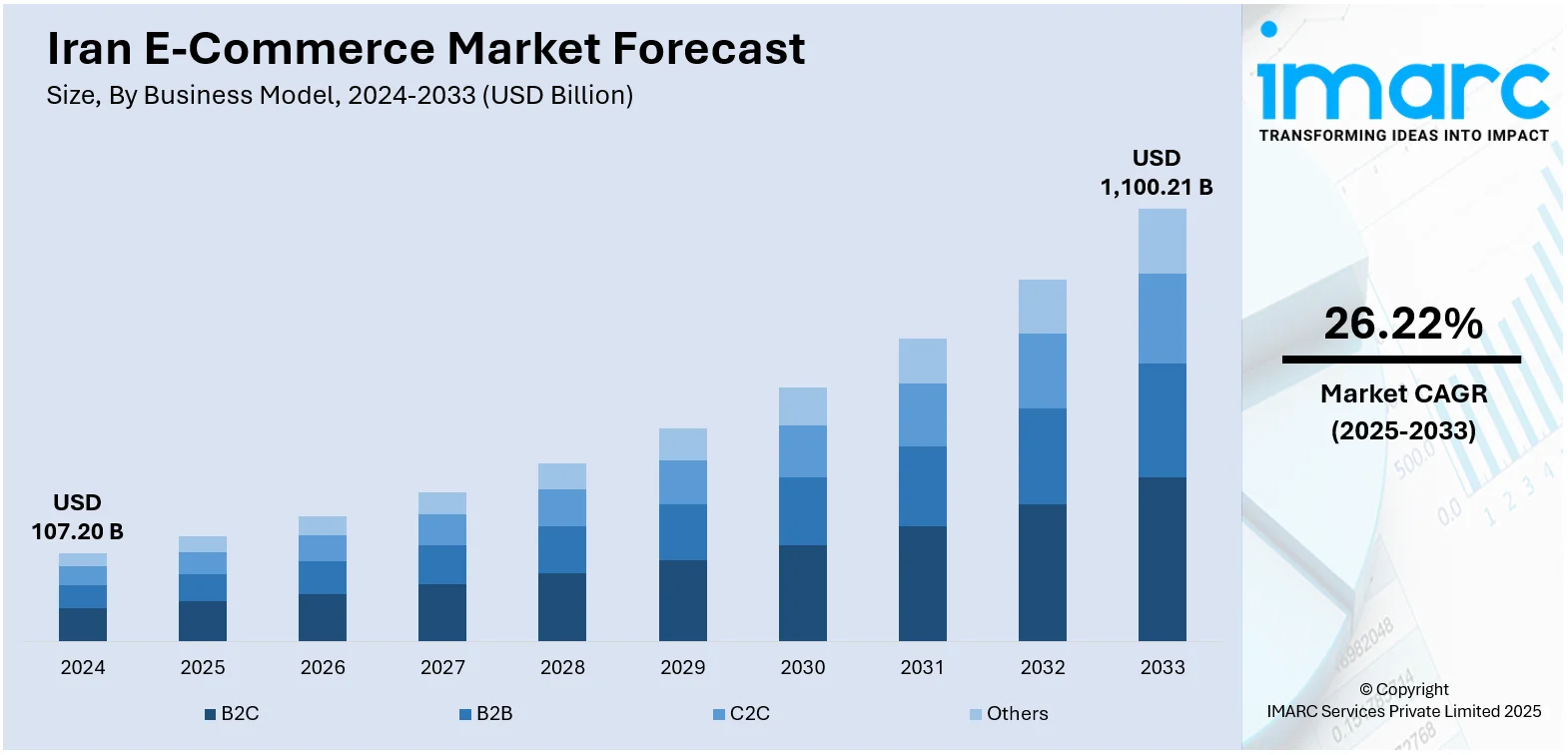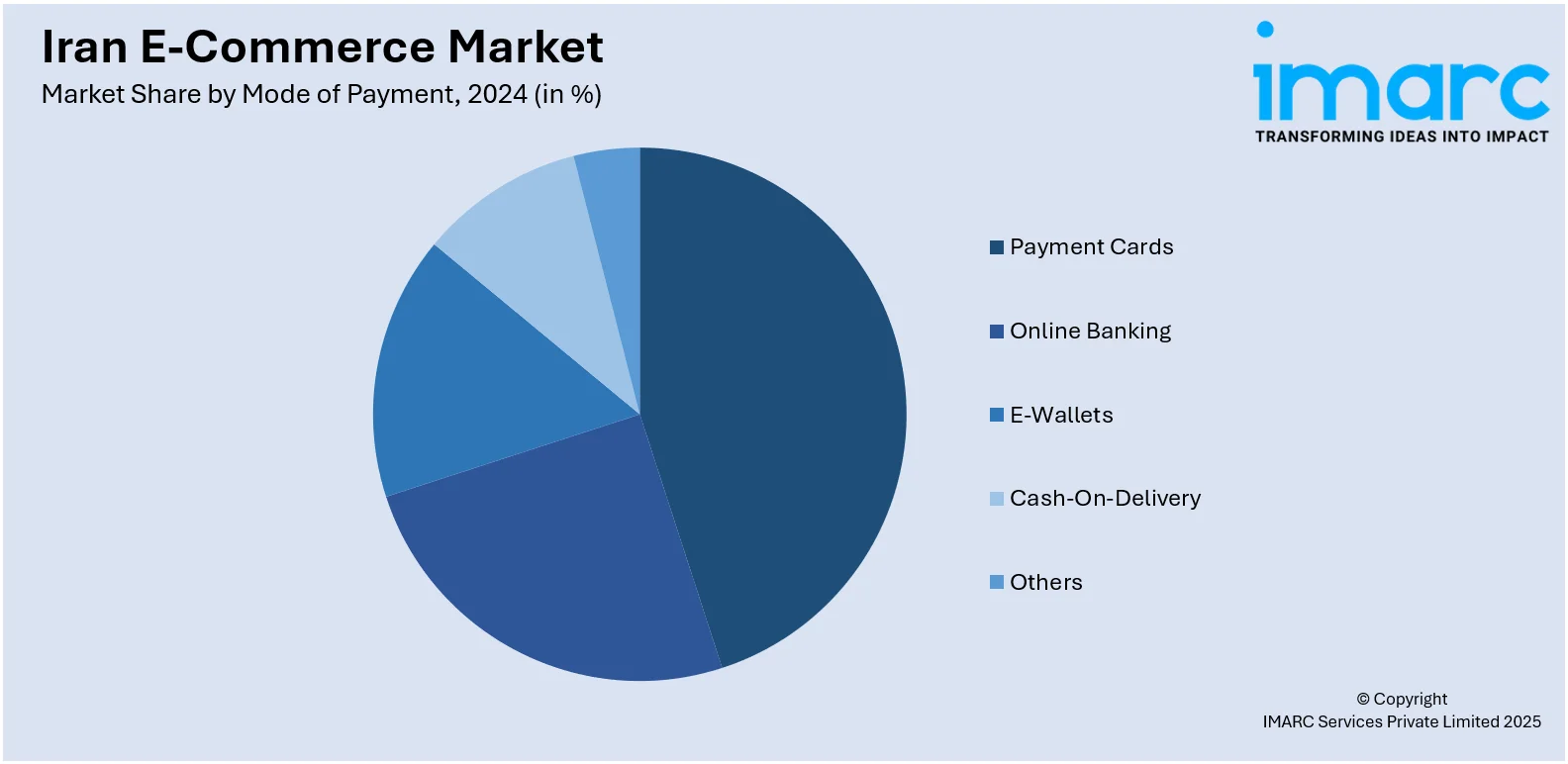
Iran E-Commerce Market Size, Share, Trends and Forecast by Business Model, Mode of Payment, Service Type, Product Type, and Province, 2025-2033
Iran E-Commerce Market Overview:
The Iran e-commerce market size reached USD 107.20 Billion in 2024. Looking forward, IMARC Group expects the market to reach USD 1,100.21 Billion by 2033, exhibiting a growth rate (CAGR) of 26.22% during 2025-2033. The e-commerce market is expanding rapidly due to increased internet access, widespread smartphone use, and tech-savvy users. Advancements in digital payments and logistics infrastructure are enabling secure transactions and timely deliveries while enhancing user experience and encouraging long-term engagement with online platforms, thereby contributing to the expansion of the Iran e-commerce market share.
|
Report Attribute
|
Key Statistics
|
|---|---|
|
Base Year
|
2024 |
|
Forecast Years
|
2025-2033
|
|
Historical Years
|
2019-2024
|
| Market Size in 2024 | USD 107.20 Billion |
| Market Forecast in 2033 | USD 1,100.21 Billion |
| Market Growth Rate 2025-2033 | 26.22% |
Iran E-Commerce Market Trends:
Increasing Internet Penetration and Smartphone Adoption
The rapid expansion of internet access and widespread smartphone adoption, which are transforming user behavior, are impelling the market growth. As more people in Iran gain access to affordable mobile devices and increasingly reliable digital infrastructure, engagement with online platforms is growing substantially. This rise in connectivity is opening new opportunities for individuals to explore and purchase a wide range of products and services without relying on traditional physical retail. Younger demographics, in particular, are highly attuned to digital environments, making mobile-based shopping an intuitive and preferred method because of its convenience and variety. The widespread use of mobile apps tailored to local preferences is further improving the user experience and accessibility of e-commerce platforms. Supporting this trend, figures from Iran’s Communications Regulatory Authority (CRA) show that mobile internet penetration rose by 6.31% in the two years to late March 2024, with the broadband mobile internet penetration rate reaching an impressive 132.01% in the quarter to March 19. Additionally, high-speed mobile internet was available to over 112 million customers during that quarter, representing a 7.1% increase compared to the same period in March 2022. This rapid growth in connectivity is effectively providing the digital foundation for Iran’s e-commerce ecosystem, seamlessly linking individuals, retailers, and payment services while driving widespread adoption across demographics.

To get more information on this market, Request Sample
Development of Payment Systems and Logistics Networks
The Iran e-commerce market growth is strongly driven by advancements in digital payment systems and the continuous evolution of logistics infrastructure, both of which are essential for enabling smooth, secure, and scalable online transactions. Reliable payment gateways, such as mobile wallets and online banking, are playing a critical role in reducing transaction friction, thereby increasing user trust in digital platforms. These systems simplify the checkout process, offer payment flexibility, and enhance the overall user experience, which in turn encourages more frequent online purchases. A major development in this space occurred in 2024 when Iran’s Central Bank announced the launch of the digital rial, a central bank digital currency (CBDC) designed to modernize the country's financial system and enhance integration with global payment trends. Piloted on Kish Island, the digital rial allows for wallet-based, card-free transactions that bypass traditional banking networks, offering faster, more secure, and more inclusive financial services. This innovation reflects Iran’s commitment to digital financial transformation, particularly as it supports the expansion of e-commerce. Parallel to these advancements, improvements in logistics, including better warehousing, route optimization, and last-mile delivery, are significantly increasing the speed and reliability of order fulfillment. Efficient logistics not only ensure timely deliveries but also play a vital role in retaining clients and driving repeat purchases. Together, the rise of digital payment innovations, such as the digital rial, and the strengthening of logistics capabilities form a resilient infrastructure that supports the long-term growth of Iran’s e-commerce ecosystem.
Iran E-Commerce Market Segmentation:
IMARC Group provides an analysis of the key trends in each segment of the market, along with forecasts at the country and province levels for 2025-2033. Our report has categorized the market based on business model, mode of payment, service type, and product type.
Business Model Insights:
- B2C
- B2B
- C2C
- Others
The report has provided a detailed breakup and analysis of the market based on the business model. This includes B2C, B2B, C2C, and others.
Mode of Payment Insights:

- Payment Cards
- Online Banking
- E-Wallets
- Cash-On-Delivery
- Others
A detailed breakup and analysis of the market based on the mode of payment have also been provided in the report. This includes payment cards, online banking, e-wallets, cash-on-delivery, and others.
Service Type Insights:
- Financial
- Digital Content
- Travel and Leisure
- E-Tailing
- Others
The report has provided a detailed breakup and analysis of the market based on the service type. This includes financial, digital content, travel and leisure, e-tailing, and others.
Product Type Insights:
- Groceries
- Clothing and Accessories
- Mobiles and Electronics
- Health and Personal Care
- Others
A detailed breakup and analysis of the market based on the product type have also been provided in the report. This includes groceries, clothing and accessories, mobiles and electronics, health and personal care, and others.
Province Insights:
- Tehran
- Khuzestan
- Bushehr
- Esfahan
- Khorasan
- Others
The report has also provided a comprehensive analysis of all the major regional markets, which include Tehran, Khuzestan, Bushehr, Esfahan, Khorasan, and others.
Competitive Landscape:
The market research report has also provided a comprehensive analysis of the competitive landscape. Competitive analysis such as market structure, key player positioning, top winning strategies, competitive dashboard, and company evaluation quadrant has been covered in the report. Also, detailed profiles of all major companies have been provided.
Iran E-Commerce Market News:
- In January 2025, the 6th Iran Retail Show was held in Tehran, featuring over 150 companies and highlighting innovations in AI, e-commerce, and entertainment. The event included 16 panels and drew attention for aligning with global retail exhibition standards. It spanned 25,000 m², making it one of the region’s largest retail events.
- In August 2024, Iran’s Center for e-Commerce Development announced plans to triple the country’s e-commerce transaction value to 90 trillion rials (about $180 million) within five years. The goal aligned with the center’s five-year development strategy.
Iran E-Commerce Market Report Coverage:
| Report Features | Details |
|---|---|
| Base Year of the Analysis | 2024 |
| Historical Period | 2019-2024 |
| Forecast Period | 2025-2033 |
| Units | Billion USD |
| Scope of the Report |
Exploration of Historical Trends and Market Outlook, Industry Catalysts and Challenges, Segment-Wise Historical and Future Market Assessment:
|
| Business Models Covered | B2C, B2B, C2C, Others |
| Mode of Payments Covered | Payment Cards, Online Banking, E-Wallets, Cash-On-Delivery, Others |
| Service Types Covered | Financial, Digital Content, Travel and Leisure, E-Tailing, Others |
| Product Types Covered | Groceries, Clothing and Accessories, Mobiles and Electronics, Health and Personal Care, Others |
| Provinces Covered | Tehran, Khuzestan, Bushehr, Esfahan, Khorasan, Others |
| Customization Scope | 10% Free Customization |
| Post-Sale Analyst Support | 10-12 Weeks |
| Delivery Format | PDF and Excel through Email (We can also provide the editable version of the report in PPT/Word format on special request) |
Key Questions Answered in This Report:
- How has the Iran e-commerce market performed so far and how will it perform in the coming years?
- What is the breakup of the Iran e-commerce market on the basis of business model?
- What is the breakup of the Iran e-commerce market on the basis of mode of payment?
- What is the breakup of the Iran e-commerce market on the basis of service type?
- What is the breakup of the Iran e-commerce market on the basis of product type?
- What is the breakup of the Iran e-commerce market on the basis of province?
- What are the various stages in the value chain of the Iran e-commerce market?
- What are the key driving factors and challenges in the Iran e-commerce market?
- What is the structure of the Iran e-commerce market and who are the key players?
- What is the degree of competition in the Iran e-commerce market?
Key Benefits for Stakeholders:
- IMARC’s industry report offers a comprehensive quantitative analysis of various market segments, historical and current market trends, market forecasts, and dynamics of the Iran e-commerce market from 2019-2033.
- The research report provides the latest information on the market drivers, challenges, and opportunities in the Iran e-commerce market.
- Porter's five forces analysis assist stakeholders in assessing the impact of new entrants, competitive rivalry, supplier power, buyer power, and the threat of substitution. It helps stakeholders to analyze the level of competition within the Iran e-commerce industry and its attractiveness.
- Competitive landscape allows stakeholders to understand their competitive environment and provides an insight into the current positions of key players in the market.
Need more help?
- Speak to our experienced analysts for insights on the current market scenarios.
- Include additional segments and countries to customize the report as per your requirement.
- Gain an unparalleled competitive advantage in your domain by understanding how to utilize the report and positively impacting your operations and revenue.
- For further assistance, please connect with our analysts.
 Request Customization
Request Customization
 Speak to an Analyst
Speak to an Analyst
 Request Brochure
Request Brochure
 Inquire Before Buying
Inquire Before Buying




.webp)




.webp)












